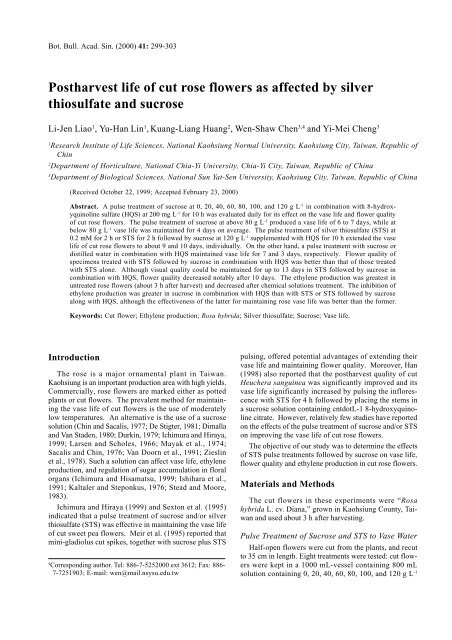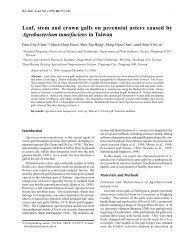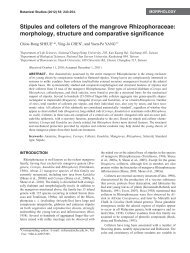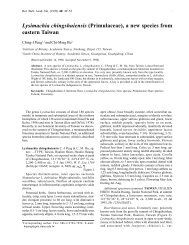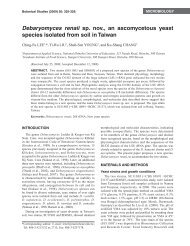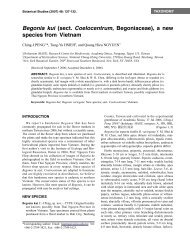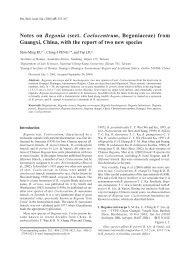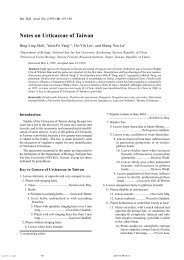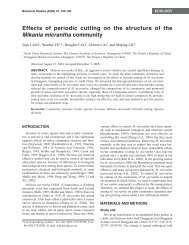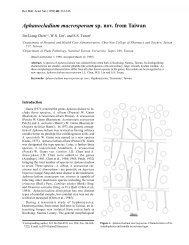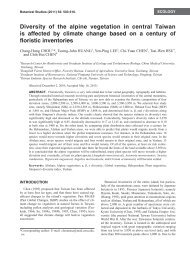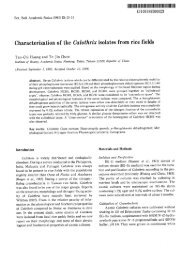Postharvest life of cut rose flowers as affected by ... - Academia Sinica
Postharvest life of cut rose flowers as affected by ... - Academia Sinica
Postharvest life of cut rose flowers as affected by ... - Academia Sinica
Create successful ePaper yourself
Turn your PDF publications into a flip-book with our unique Google optimized e-Paper software.
Liao Bot. Bull. et al. Acad. — Silver Sin. thiosulfate (2000) 41: in 299-303 relation to v<strong>as</strong>e <strong>life</strong> <strong>of</strong> <strong>cut</strong> <strong>rose</strong>s 299<br />
<strong>Postharvest</strong> <strong>life</strong> <strong>of</strong> <strong>cut</strong> <strong>rose</strong> <strong>flowers</strong> <strong>as</strong> <strong>affected</strong> <strong>by</strong> silver<br />
thiosulfate and suc<strong>rose</strong><br />
Li-Jen Liao 1 , Yu-Han Lin 1 , Kuang-Liang Huang 2 , Wen-Shaw Chen 3,4 and Yi-Mei Cheng 3<br />
1Research Institute <strong>of</strong> Life Sciences, National Kaohsiung Normal University, Kaohsiung City, Taiwan, Republic <strong>of</strong><br />
Chin<br />
2Department <strong>of</strong> Horticulture, National Chia-Yi University, Chia-Yi City, Taiwan, Republic <strong>of</strong> China<br />
3Department <strong>of</strong> Biological Sciences, National Sun Yat-Sen University, Kaohsiung City, Taiwan, Republic <strong>of</strong> China<br />
(Received October 22, 1999; Accepted February 23, 2000)<br />
Abstract. A pulse treatment <strong>of</strong> suc<strong>rose</strong> at 0, 20, 40, 60, 80, 100, and 120 g L -1 in combination with 8-hydroxyquinoline<br />
sulfate (HQS) at 200 mg L -1 for 10 h w<strong>as</strong> evaluated daily for its effect on the v<strong>as</strong>e <strong>life</strong> and flower quality<br />
<strong>of</strong> <strong>cut</strong> <strong>rose</strong> <strong>flowers</strong>. The pulse treatment <strong>of</strong> suc<strong>rose</strong> at above 80 g L -1 produced a v<strong>as</strong>e <strong>life</strong> <strong>of</strong> 6 to 7 days, while at<br />
below 80 g L -1 v<strong>as</strong>e <strong>life</strong> w<strong>as</strong> maintained for 4 days on average. The pulse treatment <strong>of</strong> silver thiosulfate (STS) at<br />
0.2 mM for 2 h or STS for 2 h followed <strong>by</strong> suc<strong>rose</strong> at 120 g L -1 supplemented with HQS for 10 h extended the v<strong>as</strong>e<br />
<strong>life</strong> <strong>of</strong> <strong>cut</strong> <strong>rose</strong> <strong>flowers</strong> to about 9 and 10 days, individually. On the other hand, a pulse treatment with suc<strong>rose</strong> or<br />
distilled water in combination with HQS maintained v<strong>as</strong>e <strong>life</strong> for 7 and 3 days, respectively. Flower quality <strong>of</strong><br />
specimens treated with STS followed <strong>by</strong> suc<strong>rose</strong> in combination with HQS w<strong>as</strong> better than that <strong>of</strong> those treated<br />
with STS alone. Although visual quality could be maintained for up to 13 days in STS followed <strong>by</strong> suc<strong>rose</strong> in<br />
combination with HQS, flower quality decre<strong>as</strong>ed notably after 10 days. The ethylene production w<strong>as</strong> greatest in<br />
untreated <strong>rose</strong> <strong>flowers</strong> (about 3 h after harvest) and decre<strong>as</strong>ed after chemical solutions treatment. The inhibition <strong>of</strong><br />
ethylene production w<strong>as</strong> greater in suc<strong>rose</strong> in combination with HQS than with STS or STS followed <strong>by</strong> suc<strong>rose</strong><br />
along with HQS, although the effectiveness <strong>of</strong> the latter for maintaining <strong>rose</strong> v<strong>as</strong>e <strong>life</strong> w<strong>as</strong> better than the former.<br />
Keywords: Cut flower; Ethylene production; Rosa hybrida; Silver thiosulfate; Suc<strong>rose</strong>; V<strong>as</strong>e <strong>life</strong>.<br />
Introduction<br />
The <strong>rose</strong> is a major ornamental plant in Taiwan.<br />
Kaohsiung is an important production area with high yields.<br />
Commercially, <strong>rose</strong> <strong>flowers</strong> are marked either <strong>as</strong> potted<br />
plants or <strong>cut</strong> <strong>flowers</strong>. The prevalent method for maintaining<br />
the v<strong>as</strong>e <strong>life</strong> <strong>of</strong> <strong>cut</strong> <strong>flowers</strong> is the use <strong>of</strong> moderately<br />
low temperatures. An alternative is the use <strong>of</strong> a suc<strong>rose</strong><br />
solution (Chin and Sacalis, 1977; De Stigter, 1981; Dimalla<br />
and Van Staden, 1980; Durkin, 1979; Ichimura and Hiraya,<br />
1999; Larsen and Scholes, 1966; Mayak et al., 1974;<br />
Sacalis and Chin, 1976; Van Doorn et al., 1991; Zieslin<br />
et al., 1978). Such a solution can affect v<strong>as</strong>e <strong>life</strong>, ethylene<br />
production, and regulation <strong>of</strong> sugar accumulation in floral<br />
organs (Ichimura and Hisamatsu, 1999; Ishihara et al.,<br />
1991; Kaltaler and Steponkus, 1976; Stead and Moore,<br />
1983).<br />
Ichimura and Hiraya (1999) and Sexton et al. (1995)<br />
indicated that a pulse treatment <strong>of</strong> suc<strong>rose</strong> and/or silver<br />
thiosulfate (STS) w<strong>as</strong> effective in maintaining the v<strong>as</strong>e <strong>life</strong><br />
<strong>of</strong> <strong>cut</strong> sweet pea <strong>flowers</strong>. Meir et al. (1995) reported that<br />
mini-gladiolus <strong>cut</strong> spikes, together with suc<strong>rose</strong> plus STS<br />
4 Corresponding author. Tel: 886-7-5252000 ext 3612; Fax: 886-<br />
7-7251903; E-mail: wen@mail.nsysu.edu.tw<br />
pulsing, <strong>of</strong>fered potential advantages <strong>of</strong> extending their<br />
v<strong>as</strong>e <strong>life</strong> and maintaining flower quality. Moreover, Han<br />
(1998) also reported that the postharvest quality <strong>of</strong> <strong>cut</strong><br />
Heuchera sanguinea w<strong>as</strong> significantly improved and its<br />
v<strong>as</strong>e <strong>life</strong> significantly incre<strong>as</strong>ed <strong>by</strong> pulsing the inflorescence<br />
with STS for 4 h followed <strong>by</strong> placing the stems in<br />
a suc<strong>rose</strong> solution containing cntdotL-1 8-hydroxyquinoline<br />
citrate. However, relatively few studies have reported<br />
on the effects <strong>of</strong> the pulse treatment <strong>of</strong> suc<strong>rose</strong> and/or STS<br />
on improving the v<strong>as</strong>e <strong>life</strong> <strong>of</strong> <strong>cut</strong> <strong>rose</strong> <strong>flowers</strong>.<br />
The objective <strong>of</strong> our study w<strong>as</strong> to determine the effects<br />
<strong>of</strong> STS pulse treatments followed <strong>by</strong> suc<strong>rose</strong> on v<strong>as</strong>e <strong>life</strong>,<br />
flower quality and ethylene production in <strong>cut</strong> <strong>rose</strong> <strong>flowers</strong>.<br />
Materials and Methods<br />
The <strong>cut</strong> <strong>flowers</strong> in these experiments were “Rosa<br />
hybrida L. cv. Diana,” grown in Kaohsiung County, Taiwan<br />
and used about 3 h after harvesting.<br />
Pulse Treatment <strong>of</strong> Suc<strong>rose</strong> and STS to V<strong>as</strong>e Water<br />
Half-open <strong>flowers</strong> were <strong>cut</strong> from the plants, and re<strong>cut</strong><br />
to 35 cm in length. Eight treatments were tested: <strong>cut</strong> <strong>flowers</strong><br />
were kept in a 1000 mL-vessel containing 800 mL<br />
solution containing 0, 20, 40, 60, 80, 100, and 120 g L-1
300 Botanical Bulletin <strong>of</strong> <strong>Academia</strong> <strong>Sinica</strong>, Vol. 41, 2000<br />
suc<strong>rose</strong> supplemented with 200 mg L -1 HQS. The pulse<br />
treatment <strong>of</strong> each solution w<strong>as</strong> kept for 10 h, and then<br />
transferred to distilled water. In addition, a pulse treatment<br />
<strong>of</strong> STS at 0.2 mM for 2 h, and STS for 2 h followed<br />
<strong>by</strong> suc<strong>rose</strong> at 120 g L -1 in combination with HQS at 200<br />
mg L -1 for 10 h w<strong>as</strong> conducted. For comparison, a 10-h<br />
pulse treatment <strong>of</strong> water control and suc<strong>rose</strong>, both containing<br />
HQS at 200 mg L -1 , w<strong>as</strong> constructed. The <strong>cut</strong> <strong>flowers</strong><br />
were maintained at 23°C under a 12-h photoperiod with<br />
15 µmol•M -2 •s -1 irradiance with cool-white fluorescent<br />
light. Flower diameters were me<strong>as</strong>ured daily. Maximum<br />
flower diameter w<strong>as</strong> recorded. The v<strong>as</strong>e <strong>life</strong> <strong>of</strong> <strong>flowers</strong><br />
w<strong>as</strong> defined <strong>as</strong> the time from harvest to the time that <strong>flowers</strong><br />
wilted or their stems became bent.<br />
Determination <strong>of</strong> Ethylene Production<br />
The <strong>flowers</strong> were detached daily after treatment. The<br />
individual flower w<strong>as</strong> sealed in a 100 mL Erlenmeyer fl<strong>as</strong>k<br />
and kept at 23°C. After 2 h, a 1 µL g<strong>as</strong> sample w<strong>as</strong> injected<br />
into a GC equipped with a sodium chloride modified<br />
Alumina Fl 60-80 column and a flame ionization<br />
detector. Standard <strong>of</strong> 1 ppm ethylene at 1 µL w<strong>as</strong> used<br />
for calibration. The peak area w<strong>as</strong> calculated with an<br />
integrator.<br />
Results and Discussion<br />
HQS is a well known germicide that h<strong>as</strong> little effect in<br />
extending the v<strong>as</strong>e <strong>life</strong> <strong>of</strong> <strong>cut</strong> <strong>flowers</strong> (De Stigter, 1981;<br />
Ichimura and Hisamatsu, 1999; Jones and Hill, 1993;<br />
Larsen and Scholes, 1966; Van Doorn et al., 1990). In our<br />
study, after a pulse treatment with HQS solution alone,<br />
the <strong>cut</strong> <strong>rose</strong> <strong>flowers</strong> did not fully open and/or opened but<br />
wilted 3 more d after treatment. Ichimura et al. (1998)<br />
also indicated that HQS alone h<strong>as</strong> little effect on the v<strong>as</strong>e<br />
<strong>life</strong> or climacteric ethylene production <strong>of</strong> <strong>cut</strong> <strong>flowers</strong>.<br />
Therefore, the effect <strong>of</strong> HQS on ethylene production w<strong>as</strong><br />
Table 1. Effects <strong>of</strong> suc<strong>rose</strong> pulse treatment at different concentrations<br />
on longevity <strong>of</strong> <strong>cut</strong> <strong>rose</strong> <strong>flowers</strong>. All solutions contained<br />
200 mg L -1 HQS, and pulse treatments were conducted<br />
for 10 h. Values are means <strong>of</strong> 3 replications ± standard errors.<br />
Concentration (g L-1 ) Flower longevity (days)<br />
0 3.3 ± 0.7<br />
20 4.2 ± 0.5<br />
40 5.1 ± 0.6<br />
60 5.8 ± 0.5<br />
80 6.2 ± 0.9<br />
100 6.7 ± 0.3<br />
120 7.4 ± 0.8<br />
Table 2. Longevity <strong>of</strong> <strong>cut</strong> <strong>rose</strong> flower <strong>as</strong> influenced <strong>by</strong> pulse<br />
treatment <strong>of</strong> suc<strong>rose</strong>, STS (0.2 mM) or STS followed <strong>by</strong> suc<strong>rose</strong>.<br />
Treatment times for STS were 2 h, and 10 h for suc<strong>rose</strong>. Suc<strong>rose</strong><br />
concentration w<strong>as</strong> kept at 120 g L -1 in combination with<br />
200 mg L -1 HQS. Values are means <strong>of</strong> 3 replications ± standard<br />
errors.<br />
Treatment Flower longevity (days)<br />
Water control (+HQS) 3.4 ± 0.3<br />
Suc<strong>rose</strong> (+HQS) 8.2 ± 0.5<br />
STS 9.1 ± 0.2<br />
STS + suc<strong>rose</strong> (+HQS) 10.2 ± 0.3<br />
Table 3. Flower diameter <strong>as</strong> <strong>affected</strong> <strong>by</strong> a pulse treatment <strong>of</strong><br />
suc<strong>rose</strong>, STS or STS followed <strong>by</strong> suc<strong>rose</strong>. Suc<strong>rose</strong> concentration<br />
w<strong>as</strong> kept at 120 g L -1 in combination with 200 mg L -1 HQS.<br />
Values are means <strong>of</strong> 3 replications ± standard errors.<br />
Treatment Flower diameter (cm)<br />
Water control (+HQS) 3.1 ± 0.2<br />
Suc<strong>rose</strong> (+HQS) 3.5 ± 0.3<br />
STS 3.8 ± 0.2<br />
STS + suc<strong>rose</strong> (+HQS) 4.5 ± 0.3<br />
Figure 1. Flower longevity <strong>of</strong> <strong>cut</strong> <strong>rose</strong>s <strong>as</strong> <strong>affected</strong> <strong>by</strong> a pulse treatment <strong>of</strong> suc<strong>rose</strong>, STS, and STS followed <strong>by</strong> suc<strong>rose</strong>. Water<br />
controls or suc<strong>rose</strong> (120 g L -1 ) contained 200 mg L -1 HQS. A, water; B, suc<strong>rose</strong>; C, STS; D, STS + suc<strong>rose</strong>. Photographs were taken<br />
8 d after treatment.
Liao et al. — Silver thiosulfate in relation to v<strong>as</strong>e <strong>life</strong> <strong>of</strong> <strong>cut</strong> <strong>rose</strong>s 301<br />
ignored, and the v<strong>as</strong>e <strong>life</strong> <strong>of</strong> the <strong>rose</strong> <strong>cut</strong> <strong>flowers</strong> w<strong>as</strong> attributed<br />
to suc<strong>rose</strong> and STS.<br />
Ichimura and Hiraya (1999) reported that the pulse<br />
treatment with 100 g L -1 suc<strong>rose</strong> in combination with 200<br />
mg L -1 HQS for 16 h had a significant effect on extending<br />
the v<strong>as</strong>e <strong>life</strong> <strong>of</strong> <strong>cut</strong> sweet pea <strong>flowers</strong>. Mor et al. (1984)<br />
also indicated that a pulse treatment with STS or STS with<br />
4% suc<strong>rose</strong> w<strong>as</strong> markedly effective in extending the v<strong>as</strong>e<br />
<strong>life</strong> <strong>of</strong> the same species. We found that a pulse treatment<br />
<strong>of</strong> suc<strong>rose</strong> at 120 g L -1 for 10 h had higher v<strong>as</strong>e <strong>life</strong> and<br />
flower quality in <strong>cut</strong> <strong>rose</strong> <strong>flowers</strong> (Table 1). However,<br />
suc<strong>rose</strong> concentrations over 120 g L -1 in the pulse treatment<br />
had little positive effect on v<strong>as</strong>e <strong>life</strong> or flower quality<br />
in <strong>rose</strong>s (data not shown). In addition, <strong>flowers</strong> with<br />
suc<strong>rose</strong> concentration at 120 g L -1 opened later or wilted<br />
earlier <strong>as</strong> compared with the plants placed in STS or STS<br />
followed <strong>by</strong> suc<strong>rose</strong> (Figure 1). These results indicate that<br />
a pulse treatment with an optimal suc<strong>rose</strong> solution h<strong>as</strong> a<br />
pronounced effect on v<strong>as</strong>e <strong>life</strong> and flower quality in <strong>cut</strong><br />
<strong>rose</strong> <strong>flowers</strong>. Kaltaler and Steponkus (1976) reported that<br />
exogenous sugars may somehow be maintaining the structural<br />
integrity <strong>of</strong> the cell membranes <strong>of</strong> <strong>rose</strong> <strong>flowers</strong>.<br />
Therefore, leakage <strong>of</strong> these substrates is prevented and/<br />
or reduced <strong>by</strong> sugar treatment. Aarts (1957) also suggested<br />
that exogenous suc<strong>rose</strong> in some way maintains the<br />
structure and semi-permeability <strong>of</strong> the pl<strong>as</strong>ma membrane.<br />
Furthermore, treatment <strong>of</strong> <strong>cut</strong> <strong>flowers</strong> with suc<strong>rose</strong> is<br />
found to be beneficial in delaying senescence processes<br />
(Chung et al., 1997; Yakimova et al., 1996). In our study,<br />
a pulse treatment <strong>of</strong> suc<strong>rose</strong> in combination with HQS<br />
extended the v<strong>as</strong>e <strong>life</strong> <strong>of</strong> <strong>cut</strong> <strong>rose</strong> <strong>flowers</strong>, suggesting that<br />
the suc<strong>rose</strong> might be required <strong>as</strong> an osmolyte for flower<br />
opening and substrate for cell wall synthesis and<br />
respiration. Also, In this study a pulse treatment with<br />
STS alone or STS followed <strong>by</strong> suc<strong>rose</strong> showed more positive<br />
effects on the v<strong>as</strong>e <strong>life</strong> <strong>of</strong> <strong>cut</strong> <strong>rose</strong> <strong>flowers</strong> than water<br />
controls or suc<strong>rose</strong> alone (Figure 1, Table 2). However,<br />
no marked difference in v<strong>as</strong>e <strong>life</strong> between STS and STS<br />
followed <strong>by</strong> suc<strong>rose</strong> w<strong>as</strong> found, although the latter showed<br />
a slightly greater positive effect than the former. This is<br />
in agreement with the findings obtained on sweet pea<br />
<strong>flowers</strong> <strong>by</strong> Ichimura and Hiraya (1999) and on Gypsophila<br />
<strong>by</strong> Van Doorn and Reid (1992)<br />
Many studies have reported on the application <strong>of</strong> suc<strong>rose</strong><br />
in extending the v<strong>as</strong>e <strong>life</strong> <strong>of</strong> <strong>cut</strong> <strong>flowers</strong>. For<br />
example, Paulin and Jamain (1982) and Kaltaler and<br />
Steponkus (1976) demonstrated the v<strong>as</strong>e <strong>life</strong> <strong>of</strong> <strong>cut</strong> carnations<br />
and <strong>rose</strong>s, respectively, incre<strong>as</strong>ed following suc<strong>rose</strong><br />
treatment. In our study, the incre<strong>as</strong>e in v<strong>as</strong>e <strong>life</strong> <strong>by</strong><br />
the pulse treatment with suc<strong>rose</strong> w<strong>as</strong> significant in comparison<br />
to water controls. Our results are also in agreement<br />
with those <strong>of</strong> Ichimura and Hiraya (1999), who<br />
demonstrated that suc<strong>rose</strong> pulse treatment incre<strong>as</strong>ed the<br />
v<strong>as</strong>e <strong>life</strong> <strong>of</strong> <strong>cut</strong> sweet pea <strong>flowers</strong>. Although a pulse treatment<br />
<strong>of</strong> suc<strong>rose</strong> generally incre<strong>as</strong>es the v<strong>as</strong>e <strong>life</strong> <strong>of</strong> <strong>flowers</strong>,<br />
v<strong>as</strong>e <strong>life</strong> <strong>of</strong> <strong>cut</strong> <strong>rose</strong> <strong>flowers</strong> w<strong>as</strong> less <strong>affected</strong> <strong>by</strong> suc<strong>rose</strong><br />
than STS alone or STS followed <strong>by</strong> suc<strong>rose</strong> (Table 2).<br />
Furthermore, the v<strong>as</strong>e <strong>life</strong> <strong>of</strong> <strong>cut</strong> <strong>rose</strong> <strong>flowers</strong> w<strong>as</strong> pro-<br />
Figure 2. Ethylene production <strong>of</strong> <strong>rose</strong> <strong>cut</strong> <strong>flowers</strong> <strong>as</strong> <strong>affected</strong><br />
<strong>by</strong> a pulse treatment <strong>of</strong> suc<strong>rose</strong>, STS, and STS followed <strong>by</strong><br />
suc<strong>rose</strong>. Water controls or suc<strong>rose</strong> (120 g L -1 ) contained 200<br />
mg L -1 HQS. Vertical bars denote ± standard errors.<br />
longed slightly more <strong>by</strong> a pulse treatment with STS followed<br />
<strong>by</strong> suc<strong>rose</strong> than <strong>by</strong> STS alone. In addition, the greatest<br />
effect <strong>of</strong> flower diameter w<strong>as</strong> recorded with STS<br />
followed <strong>by</strong> suc<strong>rose</strong> (Table 3). Therefore, it is clear that<br />
STS plays a key role in the maintenance <strong>of</strong> the v<strong>as</strong>e <strong>life</strong><br />
<strong>of</strong> <strong>cut</strong> <strong>rose</strong> <strong>flowers</strong>. The STS mechanism in extending<br />
the v<strong>as</strong>e <strong>life</strong> <strong>of</strong> <strong>cut</strong> <strong>flowers</strong> is related to suppression in the<br />
induction <strong>of</strong> autocatalytic production (Ichimura and<br />
Hiraya, 1999; Mor et al., 1984; Sexton et al., 1995) although<br />
the inhibition <strong>of</strong> ethylene production w<strong>as</strong> lesser<br />
than that <strong>of</strong> suc<strong>rose</strong> treatment.<br />
Ethylene production w<strong>as</strong> more significantly inhibited<br />
<strong>by</strong> suc<strong>rose</strong> than <strong>by</strong> STS (Figure 2). STS is an ethylene<br />
action inhibitor (Eapen and George, 1997; Sarkar et al.,<br />
1999) while suc<strong>rose</strong> might directly suppress ACC oxid<strong>as</strong>e<br />
or ACC synth<strong>as</strong>e activity or gene expression (Nakai et<br />
al., 1997; Yu et al., 1998). Our recommendation is for<br />
an STS pulse treatment (for 2 h) followed <strong>by</strong> suc<strong>rose</strong> in<br />
combination with HQS for 10 h, which produced good<br />
results in both flower quality and v<strong>as</strong>e <strong>life</strong> in <strong>rose</strong> <strong>cut</strong><br />
<strong>flowers</strong>.<br />
Acknowledgements. We thank Dr. Zin-Huang Liu for use <strong>of</strong><br />
the g<strong>as</strong> chromatograph.<br />
Literature Cited<br />
Aarts, J.F.T. 1957. On the keepability <strong>of</strong> <strong>cut</strong> <strong>flowers</strong>. Meded.<br />
Landbouwhogesch. Wageningen 57: 1-62.
302 Botanical Bulletin <strong>of</strong> <strong>Academia</strong> <strong>Sinica</strong>, Vol. 41, 2000<br />
Chin, C.K. and J.N. Sacalis. 1977. Metabolism <strong>of</strong> suc<strong>rose</strong> in<br />
<strong>cut</strong> <strong>rose</strong>s. II. Movement and inversion <strong>of</strong> suc<strong>rose</strong> absorbed<br />
<strong>by</strong> <strong>cut</strong> <strong>rose</strong> stems. J. Amer. Soc. Hort. Sci. 102: 537-540.<br />
Chung, B.C., S.Y. Lee, S.A. Oh, T.H. Rhew, H.G. Nam, and<br />
C.H. Lee. 1997. The promoter activity <strong>of</strong> sen 1, a senescence-<strong>as</strong>sociated<br />
gene <strong>of</strong> Arabidopsis, is repressed <strong>by</strong><br />
sugars. J. Plant Physiol. 151: 339-345.<br />
De Stigter, H.C.M. 1981. Effects <strong>of</strong> glucose with 8-hydroxyquinoline<br />
sulfate or aluminium sulfate on the water balance<br />
<strong>of</strong> <strong>cut</strong> Sonia <strong>rose</strong>s. Z. Pflanzenphysiol. 101: 95-105.<br />
Dimalla, G.G. and J. Van Staden. 1980. The effect <strong>of</strong> silver<br />
thiosulfate preservative on the physiology <strong>of</strong> <strong>cut</strong> carnations.<br />
1. Influence on longevity and carbohydrate status. Z.<br />
Pflanzenphysiol. 99: 9-17.<br />
Durkin, D.J. 1979. Effect <strong>of</strong> Millipore filtration, citric acid, and<br />
suc<strong>rose</strong> on peduncle water potential <strong>of</strong> <strong>cut</strong> <strong>rose</strong> flower. J.<br />
Amer. Soc. Hort. Sci. 104: 860-863.<br />
Eapen, S. and L. George. 1997. Plant regeneration from peduncle<br />
segments <strong>of</strong> oil seed Br<strong>as</strong>sica species: Influence <strong>of</strong> silver<br />
nitrate and silver thiosulfate. Plant Cell Tissue Organ Cult.<br />
51: 229-232.<br />
Han, S.S. 1998. <strong>Postharvest</strong> handling <strong>of</strong> <strong>cut</strong> Heuchera sanguinea<br />
Engelm. <strong>flowers</strong>: Effects <strong>of</strong> suc<strong>rose</strong> and silver thiosulfate.<br />
HortScience 33: 731-733.<br />
Ichimura, K. and T. Hisamatsu. 1999. Effects <strong>of</strong> continuous treatments<br />
with suc<strong>rose</strong> on the v<strong>as</strong>e <strong>life</strong>, soluble carbohydrate<br />
concentrations, and ethylene production <strong>of</strong> <strong>cut</strong> snapdragon<br />
<strong>flowers</strong>. J. Japan. Soc. Hort. Sci. 68: 61-66.<br />
Ichimura, K. and T. Hiraya. 1999. Effect <strong>of</strong> siver thiosulfate complex<br />
(STS) in combination with suc<strong>rose</strong> on the v<strong>as</strong>e <strong>life</strong> <strong>of</strong><br />
<strong>cut</strong> sweet pea <strong>flowers</strong>. J. Japan. Soc. Hort. Sci. 68: 23-27.<br />
Ichimura, K., M. Muk<strong>as</strong>a, T. Fujiwara, K. Kohata, and K. Suto.<br />
1998. Improvement <strong>of</strong> postharvest <strong>life</strong> and changes in sugar<br />
concentrations <strong>by</strong> suc<strong>rose</strong> treatment in bud <strong>cut</strong> sweet pea.<br />
Bull. Natl. Res. Inst. Veg. Ornamental Plants Tea 13: 41-<br />
49.<br />
Ishihara, Y., K. Ohkawa, and H. Hyodo. 1991. Senescence <strong>of</strong><br />
<strong>cut</strong> sweet pea <strong>flowers</strong> and ethylene production. J. Japan. Soc.<br />
Hort. Sci. 60: 141-147.<br />
Jones, R.B. and M. Hill. 1993. The effect <strong>of</strong> germicides on the<br />
longevity <strong>of</strong> <strong>cut</strong> <strong>flowers</strong>. J. Amer. Soc. Hort. Sci. 118: 350-<br />
354.<br />
Kaltaler, R.E.L. and P. L. Steponkus. 1976. Factors affecting<br />
respiration in <strong>cut</strong> <strong>rose</strong>s. J. Amer. Soc. Hort. Sci. 101: 352-<br />
354.<br />
Larsen, F.E. and J.F. Scholes. 1966. Effects <strong>of</strong> 8-hydroxyquinoline<br />
citrate, N-dimethyl amino succinamic acid, and suc<strong>rose</strong><br />
on v<strong>as</strong>e-<strong>life</strong> and spike characteristics <strong>of</strong> <strong>cut</strong> snapdragon.<br />
Proc. Amer. Soc. Hort. Sci. 89: 694-701.<br />
Mayak, S., A.H. Halevy, S. Sagie, A. Bar-Yoseph, and B.<br />
Bravdo. 1974. The water balance <strong>of</strong> <strong>cut</strong> <strong>rose</strong> <strong>flowers</strong>.<br />
Physiol. Plant. 31: 15-22.<br />
Meir, S., S. Philosoph-Had<strong>as</strong>, R. Michaeli, and H. Davidson.<br />
1995. Improvement <strong>of</strong> the keeping quality <strong>of</strong> mini-gladiolus<br />
spikes during prolonged storage <strong>by</strong> suc<strong>rose</strong> pulsing<br />
and modified atmosphere packaging. Acta Hort. 405: 335-<br />
342.<br />
Mor, Y., M.S. Reid, and A.M. K<strong>of</strong>ranek. 1984. Pulse treatments<br />
with silver sulfate and suc<strong>rose</strong> improve the v<strong>as</strong>e <strong>life</strong> <strong>of</strong><br />
sweet pe<strong>as</strong>. J. Amer. Soc. Hort. Sci. 109: 866-868.<br />
Nakai, T., N. Tonouchi, T. Tsuchida, H. Mori, F. Sakai, and T.<br />
Hayishi. 1997. Synthesis <strong>of</strong> <strong>as</strong>ymmetrically labeled suc<strong>rose</strong><br />
<strong>by</strong> a recombinant suc<strong>rose</strong> synth<strong>as</strong>e. Bioscience Biotech.<br />
Biochem. 61: 1955-1956.<br />
Paulin, A. and C. Jamain. 1982. Development <strong>of</strong> <strong>flowers</strong> and<br />
changes in various sugars during opening <strong>of</strong> <strong>cut</strong> carnations.<br />
J. Amer. Soc. Hort. Sci. 107: 258-261.<br />
Sacalis, J.N. and C.K. Chin. 1976. Metabolism <strong>of</strong> suc<strong>rose</strong> in <strong>cut</strong><br />
<strong>rose</strong>s. I. Comparison <strong>of</strong> suc<strong>rose</strong> pulse and continuous suc<strong>rose</strong><br />
uptake. J. Amer. Soc. Hort. Sci. 101: 254-257.<br />
Sarkar, D., S.K. Kaushik, and P.S. Naik. 1999. Minimal growth<br />
conservation <strong>of</strong> potato microplants: Silver thiosulfate reduces<br />
ethylene-induced growth abnormalities during prolonged<br />
storage in vitro. Plant Cell Rep. 18: 897-903.<br />
Sexton, R., A.E. Porter, S. Littlejohns, and S.C. Thain. 1995.<br />
Effects <strong>of</strong> diazocyclopentadiene (DACP) and silver thiosulfate<br />
(STS) on ethylene regulated abscission <strong>of</strong> sweet pea<br />
<strong>flowers</strong> (Lathyrus odoratus L.). Ann. Bot. 75: 337-342.<br />
Stead, A.D. and K.G. Moore. 1983. Studies on flower longevity<br />
in Digitalis. The role <strong>of</strong> ethylene in corolla abscission. Planta<br />
157: 15-21.<br />
Van Doorn, W.G., G. Groenewegen, P.A. Van de Pol, and C.E.<br />
M. Berkholst. 1991. Effects <strong>of</strong> carbohydrate and water status<br />
on flower opening <strong>of</strong> <strong>cut</strong> Madelon <strong>rose</strong>s. Postharv. Biol.<br />
Techno. 1: 47-57.<br />
Van Doorn, W.G. and M. S. Reid. 1992. Role <strong>of</strong> ethylene in<br />
flower senescence <strong>of</strong> Gypsophila paniculata L. <strong>Postharvest</strong><br />
Biol. Technol. 1: 265-272.<br />
Van Doorn, W.G., Y. De Witte, and R.R.J. Perik. 1990. Effect<br />
<strong>of</strong> antimicrobial compounds on the number <strong>of</strong> bacteria in<br />
stems <strong>of</strong> <strong>cut</strong> <strong>rose</strong> <strong>flowers</strong>. J. Appl. Bacteriol. 68: 117-122.<br />
Yakimova, E., T.V. Kapchina, V. Alexieva, I. Sergiev, and E.<br />
Karanov. 1996. Effect <strong>of</strong> chlorsulfuron (Glean-75) and suc<strong>rose</strong><br />
on some post-harvest physiological events in <strong>cut</strong><br />
<strong>flowers</strong>. Bulgarian J. Plant Physiol. 22: 74-87.<br />
Yu, S.J., S. Kim, J.S. Lee, and D.H. Lee. 1998. Differential accumulation<br />
<strong>of</strong> transcripts for ACC synth<strong>as</strong>e and ACC oxid<strong>as</strong>e<br />
homologs in etiolated mung bean hypocotyls in<br />
response to various stimuli. Mol. Cell. 8: 350-358.<br />
Zieslin, N., H.C. Kohl Jr., M.C. K<strong>of</strong>ranek, and A.H. Halevy.<br />
1978. Changes in the water status <strong>of</strong> <strong>cut</strong> <strong>rose</strong>s and its relationship<br />
to bent-neck phenomenon. J. Amer. Soc. Hort. Sci.<br />
103: 176-179.
Liao et al. — Silver thiosulfate in relation to v<strong>as</strong>e <strong>life</strong> <strong>of</strong> <strong>cut</strong> <strong>rose</strong>s 303<br />
Rosa hybrida L. cv. Diana 0, 20, 40, 60, 80, 100 120<br />
8-hydroxyquinoline sulfate 200 mg L -1<br />
120 g<br />
120 g L -1 HQS 200 mg L -1


